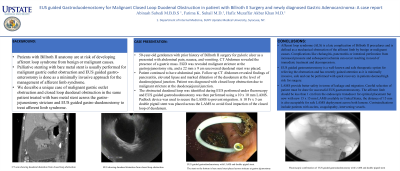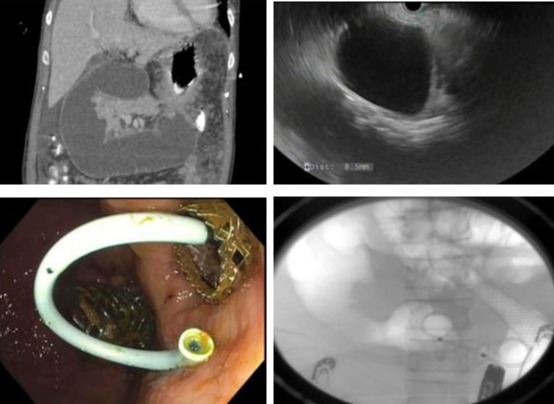Monday Poster Session
Category: Interventional Endoscopy
P2333 - EUS-Guided Gastroduodenostomy for Malignant Closed Loop Duodenal Obstruction in Patient With Billroth II Surgery and Newly Diagnosed Gastric Adenocarcinoma
Monday, October 23, 2023
10:30 AM - 4:15 PM PT
Location: Exhibit Hall

Has Audio

Abinash Subedi, MBBS
SUNY Upstate Medical University
Syracuse, NY
Presenting Author(s)
Abinash Subedi, MBBS, Fathima Keshia Suhail, MD, Hafiz M. Khan, MD
SUNY Upstate Medical University, Syracuse, NY
Introduction: Patients with Billroth II anatomy are at risk of developing afferent loop syndrome from benign or malignant causes. Gastric outlet obstruction can also occur due to benign or malignant etiology in these patients. Palliative stenting with bare metal stent is usually performed for malignant gastric outlet obstruction and EUS guided gastro-enterostomy is done as a minimally invasive approach for the management of afferent limb syndrome.
Case Description/Methods: 50-year-old male with history of Billroth II surgery for pyloric ulcer presented with abdominal pain, nausea, and vomiting. CT Abdomen revealed a gastric mass. EGD was performed that revealed malignant stricture at the gastrojejunostomy site. A 22 mm x 9 cm uncovered duodenal stent was placed. Patient continued to have abdominal pain and was found to have pancreatitis based on CT and lab findings. Marked dilatation of the duodenum was seen and was diagnosed with closed loop obstruction due to malignant stricture at duodeno-jejunal junction.
Patient was deemed high risk candidate for surgery due to pulmonary embolism. Hence, endoscopic approach was pursued. The obstructed duodenal loop was identified during EUS performed under fluoroscopy. EUS guided gastroduodenostomy was performed using a 10 x 10 mm LAMS. Padlock device was used to secure the LAMS to prevent migration. A 10 Fr x 3 cm double pigtail stent was placed across the LAMS to avoid food impaction of the closed loop of duodenum resulting in relief of symptoms.
Discussion: We present a case of malignant gastric ulcer arising in previous Billroth II anatomy causing both efferent and afferent limb obstruction resulting in gastric outlet obstruction and afferent limb syndrome with pancreatitis. This was managed with bare metal stent for gastro-jejunostomy stricture and EUS guided gastro-duodenostomy for ALS. Afferent loop syndrome (ALS) is a late complication of Billroth II surgery. Complications like cholangitis, pancreatitis or intestinal perforation can occur. EUS guided gastroenterostomy is a minimally invasive, safe therapeutic option to relieve ALS and has short recovery period. LAMS provide better safety in terms of leakage and migration. Careful selection of patient must be done for successful EUS gastroenterostomy. The afferent limb should be less than 1 cm from the endoscopic transducer for optimal placement but with new 15 x 15 mm LAMS available, the distance of 15 mm is also acceptable. Contraindications include patients with ascites, coagulopathy, intervening vessels.

Disclosures:
Abinash Subedi, MBBS, Fathima Keshia Suhail, MD, Hafiz M. Khan, MD. P2333 - EUS-Guided Gastroduodenostomy for Malignant Closed Loop Duodenal Obstruction in Patient With Billroth II Surgery and Newly Diagnosed Gastric Adenocarcinoma, ACG 2023 Annual Scientific Meeting Abstracts. Vancouver, BC, Canada: American College of Gastroenterology.
SUNY Upstate Medical University, Syracuse, NY
Introduction: Patients with Billroth II anatomy are at risk of developing afferent loop syndrome from benign or malignant causes. Gastric outlet obstruction can also occur due to benign or malignant etiology in these patients. Palliative stenting with bare metal stent is usually performed for malignant gastric outlet obstruction and EUS guided gastro-enterostomy is done as a minimally invasive approach for the management of afferent limb syndrome.
Case Description/Methods: 50-year-old male with history of Billroth II surgery for pyloric ulcer presented with abdominal pain, nausea, and vomiting. CT Abdomen revealed a gastric mass. EGD was performed that revealed malignant stricture at the gastrojejunostomy site. A 22 mm x 9 cm uncovered duodenal stent was placed. Patient continued to have abdominal pain and was found to have pancreatitis based on CT and lab findings. Marked dilatation of the duodenum was seen and was diagnosed with closed loop obstruction due to malignant stricture at duodeno-jejunal junction.
Patient was deemed high risk candidate for surgery due to pulmonary embolism. Hence, endoscopic approach was pursued. The obstructed duodenal loop was identified during EUS performed under fluoroscopy. EUS guided gastroduodenostomy was performed using a 10 x 10 mm LAMS. Padlock device was used to secure the LAMS to prevent migration. A 10 Fr x 3 cm double pigtail stent was placed across the LAMS to avoid food impaction of the closed loop of duodenum resulting in relief of symptoms.
Discussion: We present a case of malignant gastric ulcer arising in previous Billroth II anatomy causing both efferent and afferent limb obstruction resulting in gastric outlet obstruction and afferent limb syndrome with pancreatitis. This was managed with bare metal stent for gastro-jejunostomy stricture and EUS guided gastro-duodenostomy for ALS. Afferent loop syndrome (ALS) is a late complication of Billroth II surgery. Complications like cholangitis, pancreatitis or intestinal perforation can occur. EUS guided gastroenterostomy is a minimally invasive, safe therapeutic option to relieve ALS and has short recovery period. LAMS provide better safety in terms of leakage and migration. Careful selection of patient must be done for successful EUS gastroenterostomy. The afferent limb should be less than 1 cm from the endoscopic transducer for optimal placement but with new 15 x 15 mm LAMS available, the distance of 15 mm is also acceptable. Contraindications include patients with ascites, coagulopathy, intervening vessels.

Figure: CT showing duodenal obstruction, EUS showing duodenal distention from closed loop obstruction (From top left to right)
EUS guided LAMS placement, fluoroscopic confirmation of LAMS and double pigtail stent (From bottom left to right)
EUS guided LAMS placement, fluoroscopic confirmation of LAMS and double pigtail stent (From bottom left to right)
Disclosures:
Abinash Subedi indicated no relevant financial relationships.
Fathima Keshia Suhail indicated no relevant financial relationships.
Hafiz Khan indicated no relevant financial relationships.
Abinash Subedi, MBBS, Fathima Keshia Suhail, MD, Hafiz M. Khan, MD. P2333 - EUS-Guided Gastroduodenostomy for Malignant Closed Loop Duodenal Obstruction in Patient With Billroth II Surgery and Newly Diagnosed Gastric Adenocarcinoma, ACG 2023 Annual Scientific Meeting Abstracts. Vancouver, BC, Canada: American College of Gastroenterology.
